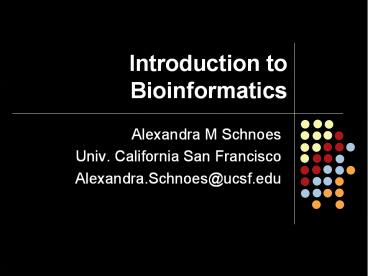Introduction to Bioinformatics PowerPoint PPT Presentation
Title: Introduction to Bioinformatics
1
Introduction to Bioinformatics
- Alexandra M Schnoes
- Univ. California San Francisco
- Alexandra.Schnoes_at_ucsf.edu
2
What is Bioinformatics?
- Intersection of Biology and Computers
- Broad field
- Often means different things to different people
- Personal Definition
- The utilization of computation for biological
investigation and discoverythe process by which
you unlock the biological world through the use
of computers.
3
What does one do in Bioinformatics? (a small
sample)
- Our Lab Understanding Protein (Enzyme) Function
- dsafd
- dsafd
?
4
What does one do in Bioinformatics? (a small
sample)
- Discover new drug targetscomputational docking
Atreya, C. E. et al. J. Biol. Chem.
200327814092-14100 Shoichet, B. K. Nature.
2004432862-865
5
What does one do in Bioinformatics? (a small
sample)
- Systems Biology
sbw.kgi.edu/ www.sbi.uni-rostock.de/
research.html
6
This lab Nucleotide Protein Informatics
- Sequence analysis
- Finding similar sequences
- Multiple sequence alignment
- Phylogenetic analysis
7
Sequence?Structure?Function
8
Process of Evolution
- Sequences change due to
- Mutation
- Insertion
- Deletion
9
Use Evolutionary Principles to Analyze Sequences
- If sequence A and sequence B are similar
- A and B evolutionarily related
- If sequence A, B and C are all similar but A and
B are more similar than A and C and B and C. - A and B are more closely evolutionarily related
to each other than to C
10
Extremely Powerful Idea
- Start with unknown sequence
- Find what the unknown is similar to
- Use information about the known to make
predictions about the unknown
11
How do you know when sequences are similar?
- Align two sequences together and score their
similarity
TASSWSYIVE TATSFSYLVG
- Use substitution matrices to score the alignment
12
Substitution Matrices Give a Score for Each
Mutation
Blosum 62 Scoring matrix
- Many different matrices available
- Blosum matrices standard in the field
http//www.carverlab.org/images/
13
Scoring Add up the positional Scores
TASSWSYIVE TATSFSYLVG
TASSWSYIVE TATSFSYLVG
- Score of 1
- Score of 30
14
Additional issues
- Gaps (insertions/deletions)
- Have scoring penalties for opening and continuing
a gap
TASSWSYIVE TASSWSYIVE TATSFLVG
TATSF--LVG
15
How do we find similar sequences?
- Start at the National Center for Biotechnology
Information - http//www.ncbi.nlm.nih.gov/
16
How do we find similar sequences?
- Nucleotide Sequence Databases
17
How do we find similar sequences?
- Protein Sequence Databases
18
How do we find similar sequences?
- Similarity Search BLAST
- Basic Local Alignment Search Tool
19
BLAST is very quick but
- Only local alignments
- Alignments arent great
- Only pair-wise alignments
20
Want better alignments
- Multiple alignment
- Multiple sequences
- Better signal to noise
- More Sequences Better alignment
- More accurate reflection of evolution
- ClustalW
- Commonly used
- Easy to use
21
Visualize the Multiple Alignment
22
Use the Alignment to Calculate Evolutionary
Distances
- See how close sequences are to each other
- Best way to tell what is most similar
- Can calculate simple tree from clustalW
Taubenberger et al., Nature 437, 889-893, 2005
23
Caveats!
- In reality
- Sequences (even parts of sequences) can evolve at
different rates - Dont have a good understanding of sequence and
function - High sequence identity does not always mean the
same function - Getting good alignments and good trees can be
very hard
24
Bioinformatics Sequence Analysis
- Start with unknown sequence
- Find similar sequences
- Create alignment
- Create phylogenetic tree
- Use information about knowns to make predictions
about unknown
25
Mini Virus Intro
- Often considered not alive
- Extremely small (much smaller than a cell)
- Cellular parasites
- Has a genome but can only reproduce inside a host
cell
26
Different Viruses
- RNA DNA viruses
- Both single and double-stranded
27
Different Viruses
- RNA DNA viruses
- Both single and double-stranded
- Influenza Virus
28
Influenza Virus (flu)
- Small genome8 RNA molecules
- Evolves quickly genetic drift, antigenic shift
29
Influenza Virus (flu)
- Sequencing
Reverse Transcriptase
Sequencing
Genomic Nucleotide Sequence
DNA
30
Influenza Pandemics
- 1918 Flu
- Killed from 50-100 Mil. people worldwide
- Considered to be one of the most deadly pandemics
- Killed many of the young and healthy
- Influenza A, Type H1N1
- Thought to have derived from Avian Influenza
- Recently reconstituted from recovered human
samples - Considerable ethical debate
31
Avian Influenza
- Current fear of pandemic
- High mortality rate (including young and healthy)
- Current concern is Influenza A, Type H5N1
- Still only transmitted by contact with birds
- Is now in Asia and Eastern and Western Europe
32
This lab Nucleotide Protein Informatics
- Sequence analysis
- Finding similar sequences
- Multiple sequence alignment
- Phylogenetic analysis
33
(No Transcript)

